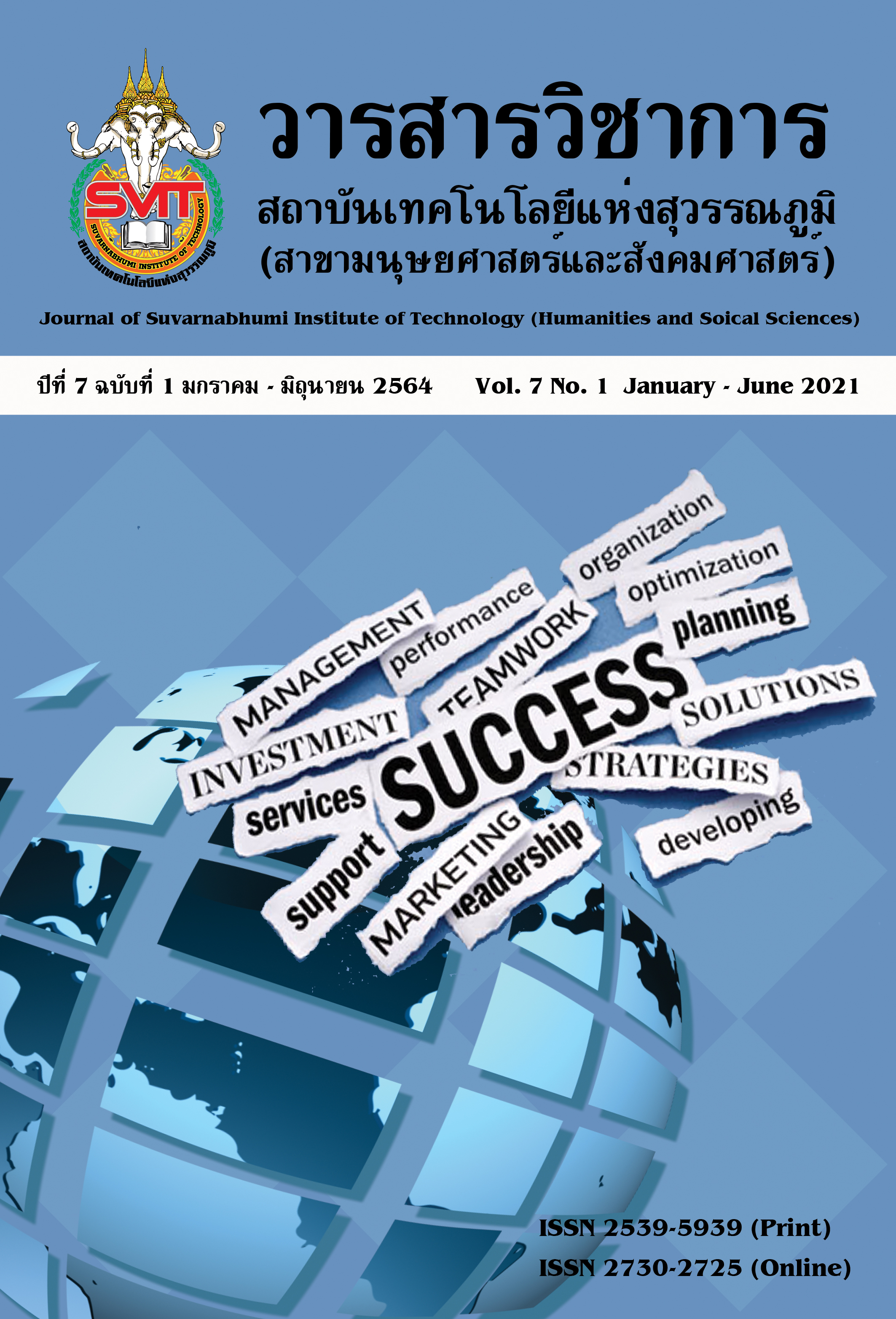THE EFFECTS OF SERVICE RECOVERY STRATEGIES ON CREDIT CARDHOLDER’S LOYALTY
Keywords:
Service Recovery Strategies, Loyalty, CreditCardAbstract
This research aims to study service recovery strategies effecting on cardholder’s loyalty. It is exploratory research. The questionnaires were used for data collection taken from the sample 407 of cardholders which happened service failures of transaction and they informed all feedback to issuer. The data analysis included Percentage, Mean, Standard Deviation and Multiple Regression Analysis at the statistical significance level of .05. The result of hypothesis testing demonstrated that compensation strategy in the customer did not participate transaction event, merchandises/ services not received event, duplicate transaction and merchandises/services not as described event had a significant effect on repurchasing with standardized regression coefficient 0.33, 0.32, 0.31 and 0.22, respectively. Moreover, compensation strategy in the event of duplicate transaction had a significant effect on word of mouth and repurchasing with standardized regression coefficient 0.31. Apology strategy in merchandises/ services not received event had a significant effect on word of mouth with standardized regression coefficient 0.35.
References
ธนาคารแห่งประเทศไทย. (2561). จำนวนบัตรพลาสติก . สืบค้นเมื่อ 15 ตุลาคม 2561, จาก www.bot.or.th
Archchana, Y. (2007). Impact of Service Recovery on Customer Loyalty: With Special Reference to People’s Bank 6th International Conference on Business & Information ICBI – 2015. Sri Lanka: Faculty of Commerce and Management Studies, University of Kelaniya.
Bell, C.R., & K. Ridge. (1992). Service recovery for trainers. Training & Development, 46(5), 58-63.
Blodgett, Jeffrey G., et al.(1997). The effects of distributive, procedural, and interactional justice on postcomplaint behavior. Journal of Retailing, 73(2), 185-210.
Cengiz, Ekrem, Bünyamin, E. and Kurtaran, A. (2007). The effects of failure recovery strategies on customer behaviours via complainants' perceptions of justice dimensions in banks.
ResearchGate, 2, 173-196.
Davidow, M. (2003). Organizational responses to customer complaints: What works and what
doesn’t. Journal of Service Research, 5(3), 225-250.
Dispute Resolution Cycle. (2018). Responding to a dispute. Retrieved form https://www.visa.co.th/
Fornell, C. (1992). A National Customer Satisfaction Barometer: The Swedish Experience. Journal of Marketing, 56, 6-21.
Hoffman, K.D., S.W. Kelley., & H.M. Rotalsky. (1995). Tracking service failures and employee recovery efforts. Journal of Services Marketing, 9(2), 49-61.
J.L. Miller., et al. (2000). The need for service recovery. Service recovery involves those actions designed. Journal of Operations Management, 18(2), 387-400.
Kau and Elizabeth. (2006). The effects of service recovery on consumer satisfaction: a comparison between complainants and non-complainants. Journal of Services Marketing, 20(2), 101-111.
Lewis, B. R., & Spyrakopoulos, S. (2001). Service Failures and Recovery in Retail Banking: The Customer Perspective. International Journal of Bank Marketing, 19(1), 37-47.
Makau, Lorna K. (2013). Customer service recovery processes: A case study of Kenya Commercial Bank (KCB) Group. (A Management Research Project Submitted in Partial Fulfilment of the Requirements for the Award of the Degree of Master of Business Administration (MBA)), School of Business, University of Nairobi.
Maxham, J. G. I., & R. G. Netemeyer. (2002). Modeling customer perceptions of complaint handling over time: The effects of perceived justice on satisfaction and intent. Journal of Retailing, 78(4), 239-252.
Michel, S. (2001). Analyzing service failures and recoveries: A process approach. International Journal of Service Industry Management, 12(1), 20-33.
Morrisson, O. and Huppertz, J.W. (2010). External Equity, Loyalty Programme Membership, and Service Recovery. Journal of Services Marketing, 24, 244-254.
Olivier Morrisson., & John W. Huppertz. (2010). External equity, loyalty program membership, and service recovery. Journal of Services Marketing, 24(3), 244-254.
Seul Lee., & Brenda J. Cude. (2012). Consumer complaint channel choice in online and offline purchases. International Journal of Consumer Studies, 1, 90-96.
Shapiro and Gonders. (2006). Effect of communication mode in justice-based service recovery. Journal of Service Theory and Practice, 16(2), 124-144.
Singh, J., & E.I. Widing Robert. (1991). What occurs once consumers complain? A theoretical model for understanding satisfaction/dissatisfaction outcomes of complaint responses. European Journal of Marketing, 25(5), 30-46.
Smith, A.K., & R.N. Bolton. (1999). An experimental investigation of customer reactions to service failure and recovery encounters: Paradox of peril. Journal of Services Research, 1(1), 65-81.
Shapiro and Gonders. (2006). Effect of communication mode in justice-based service recovery. Journal of Service Theory and Practice, 16(2), 124-144.
Swanson, S.R. and Kelley, S.W. (2001). Service recovery attributions and word-of-mouth intentions. European Journal of Marketing, 35(1/2), 194-211.
Downloads
Published
Issue
Section
License
บทความที่ได้รับการตีพิมพ์เป็นลิขสิทธิ์ของวารสารวิชาการ สถาบันเทคโนโลยีแห่งสุวรรณภูมิ
ข้อความที่ปรากฏในบทความแต่ละเรื่องในวารสารวิชาการเล่มนี้เป็นความคิดเห็นส่วนตัวของผู้เขียนแต่ละท่านไม่เกี่ยวข้องกับสถาบันเทคโนโลยีแห่งสุวรรณภูมิ และคณาจารย์ท่านอื่นๆในสถาบันฯ แต่อย่างใด ความรับผิดชอบองค์ประกอบทั้งหมดของบทความแต่ละเรื่องเป็นของผู้เขียนแต่ละท่าน หากมีความผิดพลาดใดๆ ผู้เขียนแต่ละท่านจะรับผิดชอบบทความของตนเองแต่ผู้เดียว





